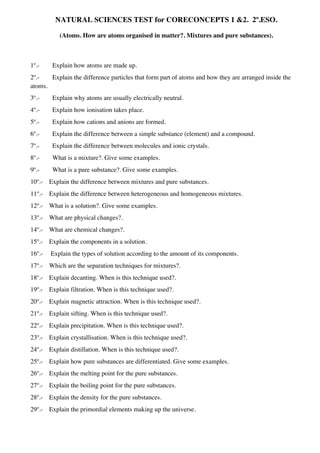Natural sciences test for coreconcepts 1
•
0 gostou•1,204 visualizações
This document contains a natural sciences test covering core concepts about atoms, mixtures, and pure substances. It includes 29 questions about the structure of atoms, ion formation, distinguishing between elements and compounds, types of mixtures and solutions, separation techniques for mixtures like decanting and filtration, and properties used to identify pure substances such as melting point, boiling point, and density.
Denunciar
Compartilhar
Denunciar
Compartilhar
Baixar para ler offline

Recomendados
Mais conteúdo relacionado
Semelhante a Natural sciences test for coreconcepts 1
Semelhante a Natural sciences test for coreconcepts 1 (19)
Mais de cariam
Mais de cariam (20)
Celebraciones campo de gibraltar (francés, 2º bilingüe)

Celebraciones campo de gibraltar (francés, 2º bilingüe)
Trabajo de egipto para frances alexandra jimenez garro

Trabajo de egipto para frances alexandra jimenez garro
Trabajo de egipto para frances alexandra jimenez garro

Trabajo de egipto para frances alexandra jimenez garro
Natural sciences test for coreconcepts 1
- 1. NATURAL SCIENCES TEST for CORECONCEPTS 1 &2. 2º.ESO. (Atoms. How are atoms organised in matter?. Mixtures and pure substances). 1º.- Explain how atoms are made up. 2º.- Explain the difference particles that form part of atoms and how they are arranged inside the atoms. 3º.- Explain why atoms are usually electrically neutral. 4º.- Explain how ionisation takes place. 5º.- Explain how cations and anions are formed. 6º.- Explain the difference between a simple substance (element) and a compound. 7º.- Explain the difference between molecules and ionic crystals. 8º.- What is a mixture?. Give some examples. 9º.- What is a pure substance?. Give some examples. 10º.- Explain the difference between mixtures and pure substances. 11º.- Explain the difference between heterogeneous and homogeneous mixtures. 12º.- What is a solution?. Give some examples. 13º.- What are physical changes?. 14º.- What are chemical changes?. 15º.- Explain the components in a solution. 16º.- Explain the types of solution according to the amount of its components. 17º.- Which are the separation techniques for mixtures?. 18º.- Explain decanting. When is this technique used?. 19º.- Explain filtration. When is this technique used?. 20º.- Explain magnetic attraction. When is this technique used?. 21º.- Explain sifting. When is this technique used?. 22º.- Explain precipitation. When is this technique used?. 23º.- Explain crystallisation. When is this technique used?. 24º.- Explain distillation. When is this technique used?. 25º.- Explain how pure substances are differentiated. Give some examples. 26º.- Explain the melting point for the pure substances. 27º.- Explain the boiling point for the pure substances. 28º.- Explain the density for the pure substances. 29º.- Explain the primordial elements making up the universe.